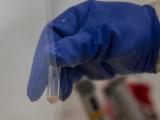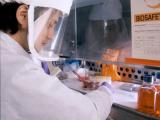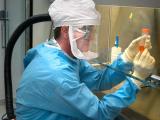Note: This story was updated Mar 14 to include information released by federal officials late on Mar 13.
Mar 13, 2002 (CIDRAP News) – A Texas laboratory worker who was analyzing environmental samples collected during last fall's anthrax outbreak has been treated for cutaneous anthrax, according to the Centers for Disease Control and Prevention (CDC). His is apparently the nation's first anthrax case since last November.
The worker, whose name was not released, was hospitalized for several days and treated with intravenous antibiotics, including ciprofloxacin and doxycycline, said Nancy Rosenstein, MD, a medical epidemiologist with the CDC's National Center for Infectious Diseases in Atlanta. She said the patient has been released from the hospital and is recovering.
The man was working in a private laboratory that has been under contract with the CDC to analyze environmental samples collected during last fall's anthrax outbreak, according to Rosenstein. "We're still investigating to try to determine how he got ill," she said. She would not disclose the name or location of the lab.
The worker sought medical attention Mar 4 for an inflamed lesion on his neck accompanied by swollen cervical lymph glands, according to a CDC press release. Rosenstein confirmed a newspaper report that the man’s physician swabbed the lesion and gave the swab to the patient to take to his own lab for analysis, instead of sending the swab to a public health laboratory for analysis.
The worker’s lab cultured Bacillus anthracis from the swab obtained by the physician, according to the CDC news release. “The isolate from this culture was sent to CDC on March 12 and CDC confirmed later that day that the isolate was Bacillus anthracis,” the release stated.
However, CDC press spokesman Tom Skinner said, "We strongly believe it's cutaneous anthrax, but it doesn't actually, from the technical standpoint, meet the specific case definition. There are circumstances in this case that may not allow us ever to say for 100% sure that it's a case" of anthrax. The CDC case definition of anthrax, as described in Morbidity and Mortality Weekly Report (Oct 19, 2001), requires clinical signs of the disease along with laboratory confirmation of Bacillus anthracis from the affected site or at least two other lab tests that support the diagnosis.
The CDC statement also said that the lab where the patient works asked the CDC to conduct a “health hazard evaluation” at the lab in an effort to learn how the worker was exposed to anthrax. The CDC sent four staff members to the site Mar 7 to do the evaluation.
Skinner said he didn't know the specific source of the environmental samples that the Texas man was analyzing when he become ill. He said many environmental samples collected after the anthrax attacks are still being analyzed.
Rosenstein said the worker's physicians decided to hospitalize him because he had anthrax even though his clinical status didn't necessarily require hospitalization. She said he was sent home with instructions to continue taking antibiotics.
In the 2001 anthrax attacks, 11 cases of inhalational anthrax and seven cases of cutaneous disease were confirmed. Five people died of the inhalational form.
See also:
CDC. Update: investigation of anthrax associated with intentional exposure and interim public health guidelines, October 2001. MMWR 2001(Oct 19):50:889-93
http://www.cdc.gov/mmwr/preview/mmwrhtml/mm5041a1.htm


















